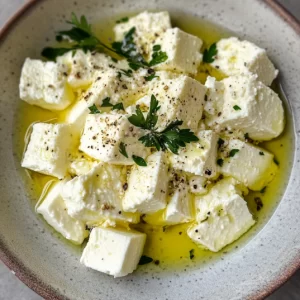
Feta Cheese Recipe
Learn how to make homemade feta cheese with this simple and easy recipe. With just a few ingredients and steps, you can create creamy, tangy feta at home for salads, appetizers, and more!
Equipment
- Large stainless steel pot (about 6-8 quart capacity)
- Thermometer
- Cheesecloth
- Cheese mold or a small colander
- Slotted spoon or ladle
- Knife for cutting curds
- Cheese press (optional for firmer feta)
- Large bowl for draining
Ingredients
- 1 gallon 4 liters whole milk (preferably raw or full-fat, not ultra-pasteurized)
- ¼ tsp mesophilic culture available from cheese-making suppliers
- ¼ tsp liquid calcium chloride optional, if using pasteurized milk
- 1/4 tsp liquid rennet or 1/4 rennet tablet, dissolved in ¼ cup water
- 1 tbsp salt
- 1-2 tbsp white vinegar or lemon juice for acidifying the milk
- Non-chlorinated water for diluting rennet and calcium chloride
Instructions
- Heat the milk:
- Pour the milk into a large stainless steel pot and slowly heat it over medium heat to 85°F (29°C). Stir occasionally to ensure the milk doesn’t scorch.
- Add the culture:
- Sprinkle the mesophilic culture over the surface of the milk and let it rehydrate for 1-2 minutes. Then, stir gently to incorporate it into the milk. Allow the milk to sit at 85°F for about 1 hour for the culture to work.
- Add the acid:
- Add vinegar or lemon juice to the milk and stir gently. This will help the milk acidify, making it ready to form curds.
- Add rennet:
- Dilute the rennet in a small amount of non-chlorinated water (about ¼ cup) and stir it into the milk. Cover the pot and let it sit undisturbed for 1-2 hours, maintaining the milk temperature at 85°F. The milk should set and form a soft curd.
- Cut the curds:
- Once the milk has set and the curds have formed, use a long knife to cut the curd into ½-inch cubes. Let the curds rest for about 5 minutes before gently stirring them with a slotted spoon.
- Cook the curds:
- Slowly heat the curds to 105°F (40°C) over the course of 30-40 minutes, stirring gently every 5 minutes. This will help the curds firm up. Once they reach the target temperature, remove them from the heat.
- Drain the curds:
- Carefully ladle the curds into a colander lined with cheesecloth, allowing the whey to drain. Let the curds drain for 1-2 hours, or until the whey has mostly drained off.
- Press the curds (optional):
- If you prefer a firmer feta, you can place the curds into a cheese mold and press them gently to expel more whey. Press the cheese for 6-12 hours, flipping the cheese occasionally to ensure an even texture.
- Salt the feta:
- Once the cheese has drained and reached the desired consistency, sprinkle the salt evenly over the surface. For a more intense flavor, you can also add herbs like oregano, thyme, or rosemary at this stage.
- Age the feta:
- Store the feta in a container filled with brine (water and salt) or olive oil in the fridge for 2-3 days to allow the flavors to develop. Feta can also be kept in a simple saltwater brine for up to 1-2 weeks.
- Serve:
- Once the feta is aged to your liking, remove it from the brine or oil and serve as a topping for salads, roasted vegetables, or in Mediterranean-inspired dishes.